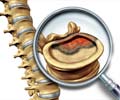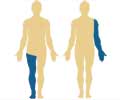In mice, the drug bortezomib preserved muscle growth and prevented loss of elbow and shoulder motion in conditions resembling the most common causes of childhood paralysis.

TOP INSIGHT
Beneficial effects of the drug Bortezomib for treating muscle contractures were strongest when given soon after birth. Further testing is required to confirm the safety of the drug.
Read More..
Many affected children require surgeries and other treatments that can temporarily relieve symptoms but do not cure the contractures. This lack of effective treatments results from doctors not knowing how muscle contractures form in childhood paralysis.
"After four weeks of treatment shortly after birth, our study found that bortezomib significantly reduced shoulder and elbow contractures in a mouse model that mimics these common childhood conditions," says Roger Cornwall, MD, Division of Pediatric Orthopaedics. "Future studies confirming the efficacy of this approach could ultimately render obsolete the destructive surgeries currently required to alleviate contractures in a variety of conditions."
Conditions affect 1 in every 200 newborns
The brachial plexus is a bundle of intertwined nerves running from the neck that control movement and sensation in the arm and hand. In some cases, these nerves can be damaged during childbirth, leading to weakness or even complete paralysis of an arm. While about two thirds of such injuries heal on their own, the rest can require nerve reconstruction and other therapies.
Combined, these conditions are the most common causes of childhood paralysis, occurring once in every 200 births. While the conditions differ in origin, both lead to similar muscle contractures that limit how well the limbs can move, and alter how the skeleton grows, leading to bone deformities and joint dislocations.
Cornwall, co-author Douglas Millay, PhD, Division of Molecular Cardiovascular Biology, and colleagues developed and studied a mouse model that mimics brachial plexus injury. They found that contractures occurred because paralyzed muscles lacked the ability to grow normally in length when deprived of critical signaling input from normal nerve fibers during early muscle development.
They further learned that healthy longitudinal muscle growth depends primarily on a balance between the synthesis and breakdown of muscle proteins. Previously, scientists had assumed muscle growth to depend primarily on the activity of stem cells, which the authors found to not be required for specifically longitudinal muscle growth.
Using that information, the team tested the drug bortezomib, a chemotherapy agent known to inhibit protein breakdown, as a possible way to re-balance muscle growth at the cellular level. The drug made a dramatic impact, but also required a second medication to reduce toxicity that proved fatal to some mice early in the study.
The beneficial effects of the drug were strongest when administered soon after birth. It remains unclear how much older children might benefit from this approach, and it's unlikely that fully grown adults could be helped this way.
Given the potential toxicity of this medication, it also remains unclear whether bortezomib, currently FDA approved for cancer treatment in adults, will be considered safe enough to test in human children in clinical trials. But the early success still points the way for researchers to develop a more refined drug that eventually could transform childhood paralysis care.
"This discovery provides, for the first time, a proof of concept that something we have always considered to be a purely mechanical consequence of limb immobility is actually a biological problem with a medical, rather than physical, solution," Cornwall says.
Source-Eurekalert
 MEDINDIA
MEDINDIA

 Email
Email










